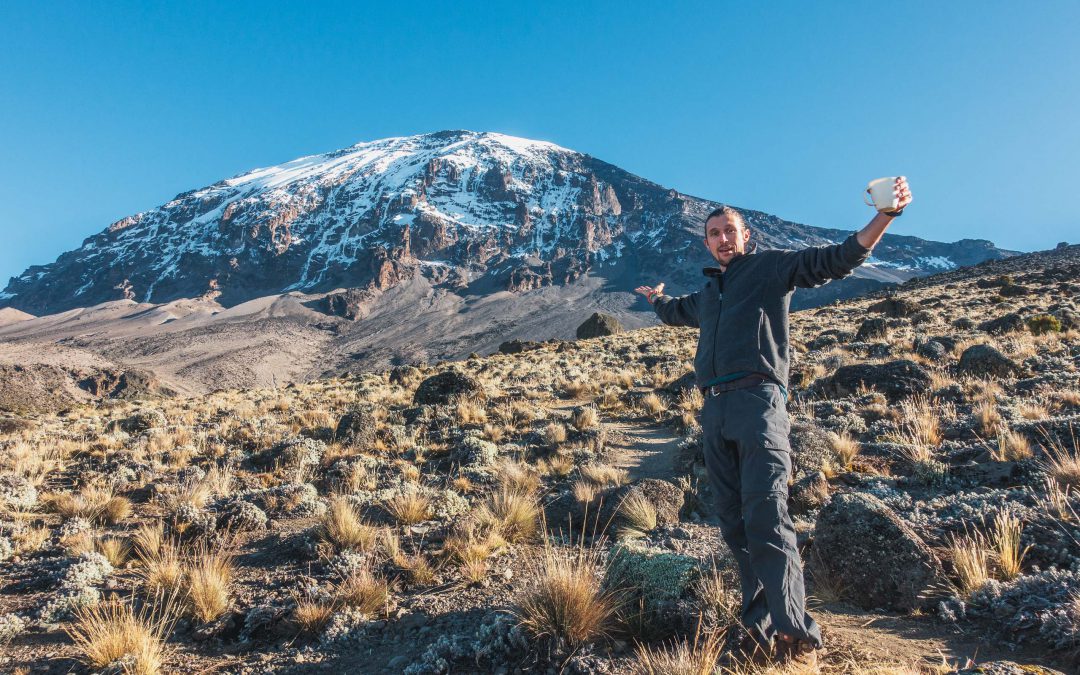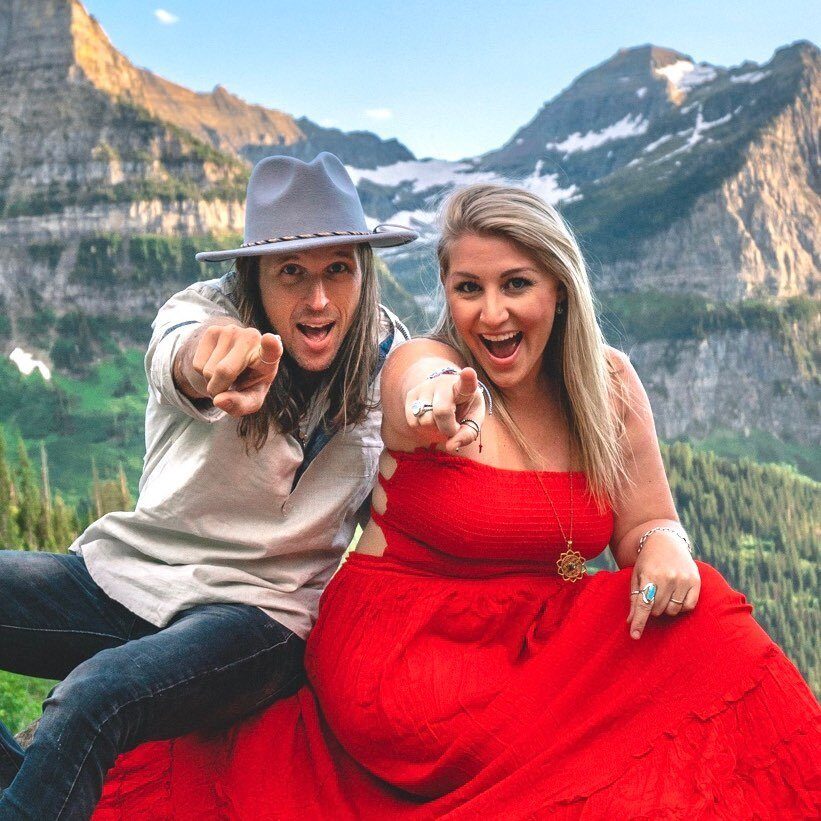From the flat and barren landscape of Amboseli National Park, in Kenya, a behemoth rises in the distant horizon. Shrouded in clouds, the point where the mountain ends and the sky begins is difficult to distinguish. The eyes strain to define the bluish-grey silhouette of the mountain slopes as your gaze works up towards the clouds. In a state of constant motion, the clouds part just enough to create a small window; a glimpse of the white snow-crowned summit of Mount Kilimanjaro.
When you lay eyes on the lone mountain for the very first time, it is a memory that will stick with you. There are countless images we’ve all seen of elephants and giraffes roaming the grasslands with the snowcapped Mt. Kilimanjaro in the backdrop. But, none genuinely do it justice until you see it in person. The scale and enormity of the mountain is surreal and can leave you feeling small.

This post is for…
..the adventurers curious about Mt Kilimanjaro, restless wanderers who seek to push themselves beyond previous boundaries, and the casual travelers who are enticed by the accomplishment of standing on the highest point in Africa. Whoever you are and whyever you found yourself here – I wish to entice and challenge you to begin your journey to Uhuru Peak.
Kilimanjaro is the highest mountain in all of Africa and the tallest freestanding mountain on the planet! This dormant volcano is located entirely inside Kilimanjaro National Park, Tanzania, near the border with Kenya. Uhuru peak is the highest point on the mountain at 5,895m / 19,341ft. On the list of most prominent mountains in the world, it ranks #4. Although located entirely in Tanzania, the most iconic views and most photos of Kilimanjaro are from Amboseli National Park in Kenya.
There are a few reasons why we wanted to climb Kilimanjaro. First, we wanted to challenge ourselves beyond anything we had done before. Neither of us are seasoned ‘mountain climbers’ by any means; so this was a true challenge for us. Reaching the summit would raise the bar on what we believed we were capable of and likely motivate us well after the climb reaching the top. Secondly, the trek to the summit is not a technical climb. Meaning, to reach Uhuru Peak climbers do not need ropes, axes or crampons. It is considered one of the worlds most accessible ‘extreme altitude’ summits. Lastly, we both wanted to be able to say we stood at the ‘top of Africa.’

What will your reasons be? Maybe it’s a bucket list item you are waiting to tick off. Perhaps you’re on a mission to collect the highest peaks around the world. Or, maybe you too are wanting to push yourself beyond your comfort zone and accept a challenge more significant than you have before. Whatever the reason may be, your interest has taken you this far. I challenge you to see it through. The feeling of accomplishment and pride from standing at the summit is worth it.
..Some Details to Consider..
Where to start?
The first thing to do is to start searching for a Guide Service / Tour Operator. There are many of them out there; some are more reputable than others though. So, make sure to read reviews from previous climbers to help make your decision.
After much review and comparison of operators, we booked our climb through ClimbingKilimanjaro.com, and we were delighted with our decision. They treated us well and made our safety a priority. I would definitely recommend considering them for your climb.
How much does it cost to climb Kilimanjaro?
I would recommend planning to spend at least $3,000(US) for a reputable Guide Service. (Note: Beware of ‘budget’ climbs and operators, they are neither safe for you as a climber nor fair to the porters who work so hard for such little pay.)
When to climb Kilimanjaro?
There are two trekking seasons for Kilimanjaro: January- March, and June-October. (March, April, and November are the wettest months on Kilimanjaro)
Which Route to choose?
Kilimanjaro has seven established climbing routes to choose from- Marangu, Machame, Lemosho, Shira, Rongai, Northern Circuit and Umbwe.
Click Here for a detailed description and map of these routes.
How long does it take to climb Kilimanjaro?
The trip will take five to eight days depending on which route you choose to climb. If you want to give yourself the best chance to summit, go with at a minimum a seven or eight-day climb.
Since Kilimanjaro is in the range of ‘very high altitude’ to ‘extreme altitude’ climbers must be sure to give their bodies as much time to adjust (or acclimatize) to the high altitude as possible. The shorter climbs are very taxing on the body and have lower success rates. Altitude sickness is the number one reason that prevents people from reaching the summit. Don’t Rush it! (Polé-Polé)
Are you fit and healthy enough for Kilimanjaro?
The answer to this you will have to determine on your own. When evaluating yourself, it helps to put into perspective what your climb will entail. During your trip, you will be on your feet every day for over a week; walking at a minimum for eight hours a day. The terrain and difficulty vary from day to day, but the pace set by the guides is intentionally slow. Also, remember you will be carrying a daypack on your back as you walk, so make sure your shoulders are used to it before you get to the mountain.
Most guide services recommend three months of training to get in shape for the mountain. In my opinion, you don’t need to train hard you need to train smart.
On a side note, Jessica is asthmatic and had her concerns about how she would do on the mountain. During our climb, she rarely had to use her inhaler and a few time had a higher blood oxygen level than I did! Of course, every person is different though. But, if you are out there thinking asthma will prevent you from reaching the summit maybe you should reconsider.
What to Expect on Kilimanjaro
The trip to the summit is not an easy one, and for some, it may be the hardest thing you have ever done. The days spent on the trail are long and will test your endurance. The guides all set a slow pace for the climbers and will repeatedly remind you to go slowly or as they say, “Polé-Polé.” This phrase becomes a bit of a mantra on the mountain. In honesty, it is a brilliant concept because it helps prevent climbers from overexerting themselves and having to stop to catch their breath, which can be difficult at high altitude. The slow pace also helps to avoid accidental injury from a misstep or slipping off a rock.
Weather is inconsistent on the mountain. One moment the sun will be out, and you’ll be pushing up your sleeves, and the next moment some clouds will roll in covering the sun and bring the cold back. There is also always a chance of rain, so it is best just to be prepared!
During the climb, there will be many other teams on the mountain with you. We were surprised just how busy the camps were in the evenings. It is by no means a hindrance though and as the days go by you will likely start to recognize familiar faces and share words of encouragement. One thing we, unfortunately, did notice is there the trash strewn along the trail. Too many people think it is acceptable to leave behind candy wrappers, juice boxes and toilet tissue. This behavior is not acceptable. Please do not be one of those people!
The nights are cold and as you get closer to the summit they get colder. Come prepared with any means you need to keep you warm at night. On the last two nights leading up to the summit, Jessica ended up using a Mylar blanket overtop her sleeping bag to stay warm.
– What We Did –
As mentioned before, after a search and comparison of operators we decided to book our climb through climbingkilimanjaro.com. Our hike started on October 3rd, coincidentally my birthday. If you are wondering, yes, we celebrated on the mountain and even had a cake that night! Our team was incredible. We took the Lemosho route and decided on an 8-day duration to give us the best chance for the summit. Our summit attempt was a great success! We both made it to the top and down safely. We couldn’t be happier with the experience we had nor more proud of ourselves for making it! In a later post share in greater detail our story to the summit via the Lemosho Route.
If you are out there trying to decide whether this is for you our not I have just a few words of encouragement. Don’t be afraid of the mountain or the climb! Just approach with a humble attitude and give it the respect it deserves. You can do it if you set your mind to it. It is only one foot in front of the other all the way to the top! When you find your self standing at Uhuru Peak, you will be so proud of what you accomplished and grateful that you were brave enough to accept the challenge.
Amazon Shopping List
To help with preparing and shopping for your trip to the roof of Africa we’ve put together an Amazon list of all the stuff we brought and/or wish we had.
Have a look Here!
Note: We are an Amazon Influencer and therefore do receive a small commission on any purchases made through the links in this post at no additional charge to you. Thank you for your support!









